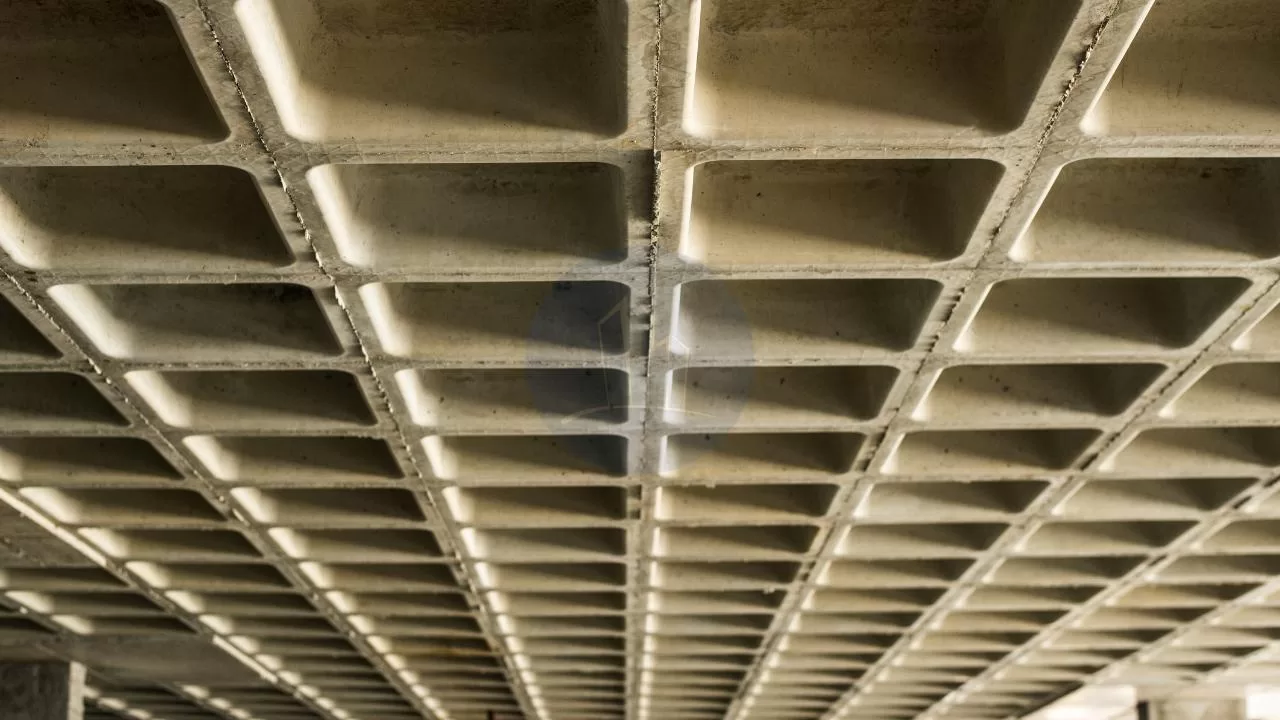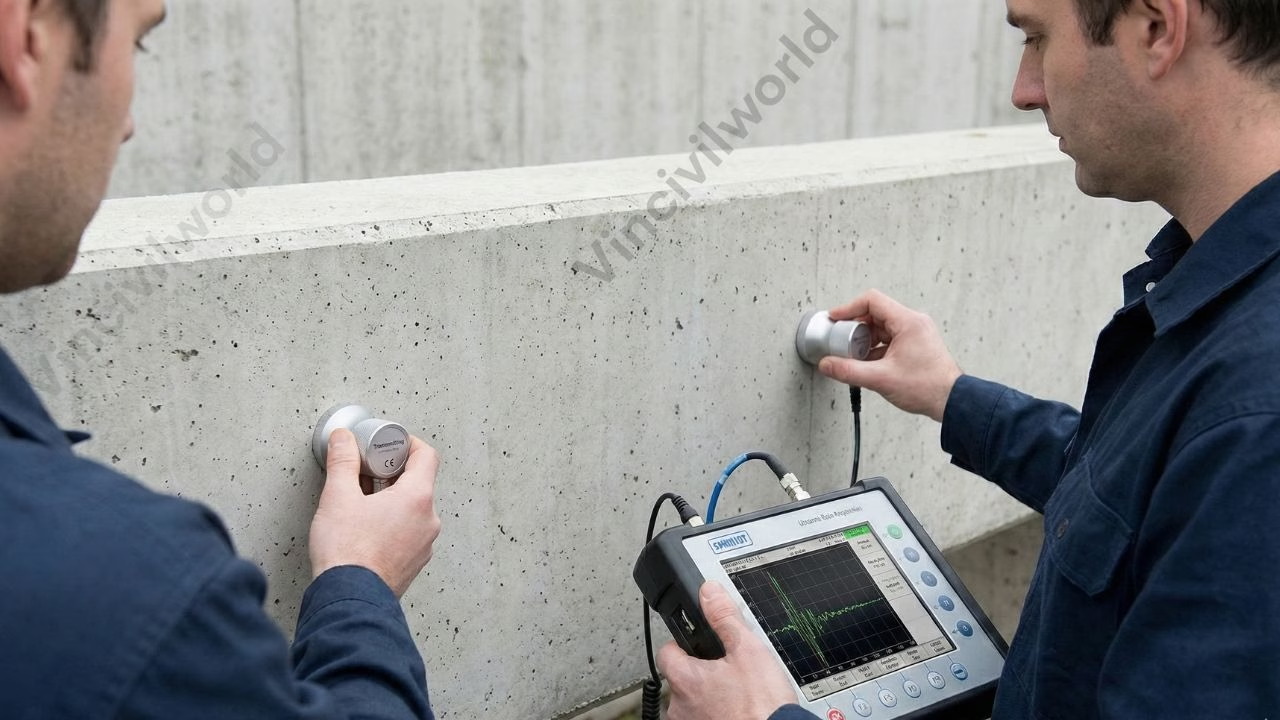Ribbed concrete slabs, also known as waffle slabs, are a type of reinforced concrete slab characterized by a grid-like pattern on the underside. This grid resembles the pockets of a waffle. It consists of ribs running in two perpendicular directions. These ribs provide enhanced strength and stability. Ribbed concrete slabs, or two-way joist slabs, are highly effective for spans over 40 feet (12 meters). They offer superior load-bearing capacity compared to other slab types, such as flat slabs, flat slabs with drop panels, two-way slabs, one-way slabs, and one-way joist slabs.
Though ribbed concrete slabs can be more expensive than other slab systems, they offer increased rigidity and stability, making them ideal for both ceiling and floor applications. These slabs are essential structural components in buildings, providing a flat surface and assisting in the transfer of loads. In this article, we will discuss the construction process, advantages, and disadvantages of ribbed concrete slabs and waffle slabs.
Table of contents
What is a ribbed concrete slab or waffle slab ?
A ribbed concrete slab, also called a waffle slab or two-way joist slab, is ideal for industrial and commercial buildings. It has a flat top and grids on the underside. Ribbed concrete slabs are stronger than flat slabs, making them perfect for longer spans. They handle both distributed and point vertical loads.

In these slabs, concrete ribs replace the bottom layer of reinforcement. The ribs run in two directions and have a depth of 135mm to 235mm. As the rib depth increases, so does the overall floor depth. This impacts the structure’s lateral loading. Ribbed concrete slabs, like waffle slabs, offer strength and stability for large buildings.
Ribbed concrete slab / Waffle slab construction details
Waffle slabs require only 70% of the concrete and 80% of the steel used for raft slabs. The construction process of a ribbed concrete slab, includes the following steps:

- Start by creating the forms for the slab.
- Place the formwork components in position.
- Position the waffle pods or molds on the shuttering. Manufacturers typically make these pods from plastic, and they come in different sizes and shapes, depending on the span length. Larger spans require more pods, and all pods should be the same size.
- Place the support components horizontally and vertically, following the connector instructions.
- Arrange the waffle pods and spacers in a grid pattern within the formwork, starting from one corner, according to the design specifications.
- Fix the pod corners to the framework using cube joints.
- Position reinforcement bars on the spacers between the waffle pods.
- Add reinforcement in both directions after securing the formwork.
- Lay out the top mesh as per the design and secure it where necessary.
- Ensure you pour the concrete, fill the connecting ribs, and vibrate the concrete for proper settling.
- After the concrete sets, remove the frames with the embedded waffles, and then carefully remove the waffle forms.
This process helps create a ribbed concrete slab, or waffle slab, that offers strength and efficiency for large spans.
You can construct a waffle slab in three ways.
- In situ construction
- Precast construction
- Prefabricated construction
In situ construction

In-situ construction of a ribbed concrete slab, or waffle slab, involves creating forms, placing waffle pods, reinforcing with steel, and pouring concrete to form a strong, durable grid structure for large spans. A slab is cast on-site in the desired size and according to the design.


Precast
Precast construction of a ribbed concrete slab, or waffle slab, involves casting the slab components in a factory. These components are then transported and assembled on-site. This method offers quicker installation and consistent quality.
Prefabricated
Prefabricated construction of a ribbed concrete slab, or waffle slab, involves manufacturing slab sections off-site. Then, they are transported and assembled on-site. This process ensures faster construction, reduced labor costs, and consistent quality.
Advantages of Waffle slab /Ribbed concrete slab
- It is suitable for large-span structures and can be achieved with less concrete and rebar than similar conventional slabs
- They require only a fewer number of columns.
- It possesses a higher load-carrying capacity
- It has higher structural stability
- They have a good aesthetic appearance.
- Waffle slabs are suitable for roof slabs and floor slabs.
- Waffle slabs have high vibration control capacity
- The construction of this slab can be done faster and easier.
- They are light weighted
- They require low construction costs, Hence they are economical when compared to other conventional slabs of the same span
- It requires only less amount concrete and can be reinforced with mesh or rebars.
Disadvantages of Waffle slab
- Requires Expensive formwork
- Requires skilled workmen and supervision for the construction.
- Higher maintenance cost
- The increase in the depth of ribs leads to an increase in the floor height.
- This type of slab is not suitable for windy and slope areas.
Key Takeaways
Ribbed concrete slabs, also known as waffle slabs, are reinforced concrete systems with a grid-like pattern on the underside. They offer enhanced strength, making them ideal for longer spans, and are highly effective in handling both distributed and point vertical loads. These slabs are suited for industrial and commercial buildings and are made using a process that involves creating forms, placing waffle pods, reinforcing with steel, and pouring concrete. Waffle slabs have advantages such as higher load-carrying capacity, stability, and aesthetic appeal. However, they require expensive formwork, skilled labor, and can incur higher maintenance costs.
Conclusion
Ribbed concrete slabs or waffle slabs are a versatile solution for large-span structures. They are stronger and more stable than conventional slabs, making them ideal for industrial, commercial, and residential buildings. Their efficient use of concrete and steel reduces material costs compared to other slab systems. However, the construction process requires skilled labor and specialized equipment, which can increase upfront costs. Despite these challenges, the long-term benefits of waffle slabs, such as reduced need for columns, higher structural stability, and aesthetic appeal, make them a valuable choice in modern construction. Understanding the advantages and disadvantages is crucial when considering them for specific projects.




